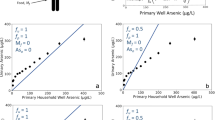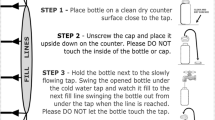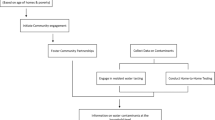Abstract
We are conducting a collaborative, population-based case-control study in Maine, New Hampshire, and Vermont to investigate the reasons for the elevated bladder cancer mortality in northern New England. Arsenic in drinking water is one of the primary exposures under investigation. To estimate subjects' lifetime exposure to waterborne arsenic, it will be necessary to obtain water samples from private wells that subjects used in the past. We conducted a methodologic study to assess the feasibility of locating and sampling from private wells at subjects' past residences. Ninety-eight New Hampshire residents (mean age 67 years) completed a questionnaire requesting the complete address, dates of occupancy, and drinking water sources for each home lived in since birth. An interviewer then asked subjects for more detailed information about each home to assist in a field search of past homes in the three-state study area of Maine, New Hampshire, and Vermont. Fifty-eight of the 98 subjects indicated that they had used a total of 103 private wells in 95 previous homes located in these three states. We conducted a field search to locate these 95 homes, visited town offices to find the properties on tax maps and obtain the current owners' names and addresses, attempted to obtain permission from the current owners to sample the wells, and collected water samples. In all, 48 (47%) of the 103 past wells in the study area were sampled successfully. The remaining wells were not sampled because the homes were not located (22%) or had been demolished (2%), permission to sample the wells was not obtained (17%), the wells had been destroyed (7%) or could not be found on the grounds of the residence (3%), or for other reasons (2%). Various approaches for improving the success rates for sampling water from private wells are discussed, as is the use of predictive modeling to impute exposures when sampling is not feasible.
This is a preview of subscription content, access via your institution
Access options
Subscribe to this journal
Receive 6 print issues and online access
$259.00 per year
only $43.17 per issue
Buy this article
- Purchase on Springer Link
- Instant access to full article PDF
Prices may be subject to local taxes which are calculated during checkout
Similar content being viewed by others
References
Ayotte JD Robinson KW . New England Coastal Basins, National Water-Quality Assessment Program: U.S. Geological Survey Water Fact Sheet FS-060-97. 4 pp. 1997
Ayotte JD Nielsen MG Robinson GR Jr. Moore RB Relation of arsenic, iron, and manganese in ground water to aquifer type, bedrock lithogeochemistry, and land use in the New England Coastal Basins. U.S. Geological Survey Water-Resources Investigations Report 99-4162. 61 pp. 1999
Cantor KP Lynch CF Hildesheim ME Dosemeci M Lubin J Alavanja M Craun G . Drinking water source and chlorination byproducts: I. Risk of bladder cancer, Epidemiology (1998) 9: 21–28
Chen CJ Chuang YC Lin TM Wu HY . Malignant neoplasms among residents of a blackfoot disease-endemic area in Taiwan: high-arsenic artesian well water and cancers, Cancer Res (1985) 45: 5895–5899
Chiou HY Chiou ST Hsu YH Chou YL Tseng CH Wei ML Chen CJ . Incidence of transitional cell carcinoma and arsenic in drinking water: a follow-up study of 8,102 residents in an arseniasis-endemic area in northeastern Taiwan, Am J Epidemiol (2001) 135 (5): 411–418
Croen LA Todoroff K Shaw GM . Maternal exposure to nitrate from drinking water and diet and risk for neural tube defects, Am J Epidemiol (2001) 153: 325–331
Devesa SS Grauman DG Blot WJ Pennello G Hoover RN Fraumeni JF Jr. Atlas of cancer mortality in the United States, 1950–1994. U.S. Government Printing Office, Washington, DC. NIH Publication No. 199-4564. 1999
Focazio MJ Welch AH Watkins SA Helsel DR Horn MA . A retrospective analysis on the occurrence of arsenic in ground-water resources of the United States and limitations in drinking-water-supply characterizations: U.S. Geological Survey Water-Resources Investigations Report 99-4279. 21 pp. 2000
Hildesheim ME Cantor KP Lynch CF Dosemeci M Lubin J Alavanja M Craun G . Drinking water source and chlorination byproducts: II. Risk of colon and rectal cancers, Epidemiology (1998) 9: 29–35
Hinkle SR Polette DJ . Arsenic in ground water of the Willamette Basin, Oregon. Water Resources Investigations Report 98-4205. U.S. Geological Survey, Portland, OR. 28 pp. 1999
Hopenhayn-Rich C Biggs ML Fuchs A Bergoglio R Tello EE Nicoll H Smith AH . Bladder cancer mortality associated with arsenic in drinking water in Argentina, Epidemiology (1996) 7: 117–124
Karagas MR Le CX Morris S Blum J Lu X Spate V Carey M Stannard V Klaue B Tosteson TD . Markers of low level arsenic exposure for evaluating human cancer risks in a US population, Int J Occup Med Environ Health (2001a) 14: 171–175
Karagas MR Stukel TA Morris JS Tosteson TD Weiss JE Spencer SK Greenberg ER . Skin cancer risk in relation to toenail arsenic concentrations in a US population-based case-control study, Am J Epidemiol (2001b) 153: 559–565
Karagas MR Tosteson TD Blum J Morris JS Baron JA Klaue B . Design of an epidemiologic study of drinking water arsenic exposure and skin and bladder cancer risk in a US population, Environ Health Perspect (1998) 106: 1047–1050
Koterba MT Wilde FD Lapham WW . Ground-water data-collection protocols and procedures for the National Water Quality Assessment program — collection and documentation of water-quality samples and related data: U.S. Geological Survey Open-File Report 95-399. 113 pp. 1995
Peters S Blum JD Karagas MR . Arsenic occurrence in New Hampshire drinking water, Environ Sci Technol (1999) 33: 1328–1333
Smith AH Goycolea M Haque R Biggs ML . Marked increase in bladder cancer and lung cancer mortality in a region of Northern Chile due to arsenic in drinking water, Am J Epidemiol (1998) 147: 660–669
Solley WB Pierce RR Perlman HA . Estimated use of water in the United States in 1995: U.S. Geological Survey Circular 1200. 71 pp. 1998
US Environmental Protection Agency. Safe drinking water query form. Available at. http://www.epa.gov/enviro/html/sdwis/sdwis_query.html. 2001
Ward MH Mark SD Cantor KP Weisenburger DD Correa-Villaseñor A Zahm SH . Drinking water nitrate and risk of non-Hodgkin's lymphoma, Epidemiology (1996) 7: 465–471
Welch AH Westjohn DB Helsel DH Wanty RH . Arsenic in ground water of the United States: occurrence and geochemistry, Ground Water (2000) 38: 589–604
Wu MM Kuo TL Hwang YH Chen CJ . Dose–response relation between arsenic concentration in well water and mortality from cancers and vascular diseases, Am J Epidemiol (1989) 130: 1123–1132
Author information
Authors and Affiliations
Corresponding author
Rights and permissions
About this article
Cite this article
COLT, J., BARIS, D., CLARK, S. et al. Sampling private wells at past homes to estimate arsenic exposure: A methodologic study in New England. J Expo Sci Environ Epidemiol 12, 329–334 (2002). https://doi.org/10.1038/sj.jea.7500235
Received:
Published:
Issue Date:
DOI: https://doi.org/10.1038/sj.jea.7500235
Keywords
This article is cited by
-
Factors influencing perceptions of private water quality in North America: a systematic review
Systematic Reviews (2019)
-
Predicting arsenic concentrations in groundwater of San Luis Valley, Colorado: implications for individual-level lifetime exposure assessment
Environmental Geochemistry and Health (2014)
-
Water quality monitoring records for estimating tap water arsenic and nitrate: a validation study
Environmental Health (2010)
-
Lifetime exposure to arsenic in residential drinking water in Central Europe
International Archives of Occupational and Environmental Health (2010)



